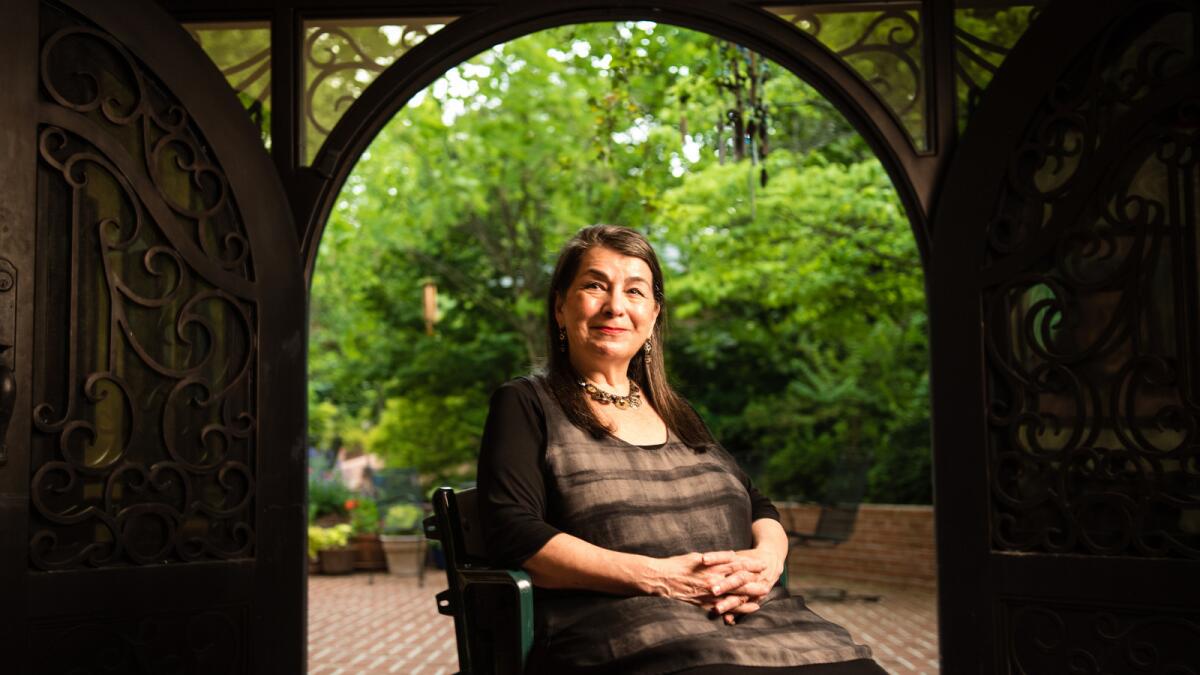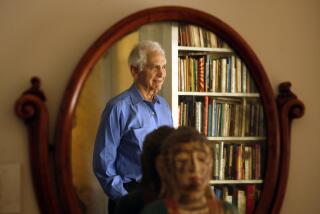Aviva Kempner doc seeks ‘the real story’ of Moe Berg, ‘The Spy Behind Home Plate’

- Share via
Moe Berg was brilliant. A true Renaissance man. He knew 10 languages, including the long dead Sanskrit. He graduated from Princeton where he battled anti-Semitism and received his law degree from Columbia. He played major league baseball for 15 seasons. He also just happened to be a spy for the Office of Strategic Services during World War II.
And now, Berg is the subject of Aviva Kempner’s new documentary “The Spy Behind Home Plate,” which opens June 7 in Los Angeles. Berg is the latest “underdog” Jewish hero Kempner has celebrated. “The Life and Times of Hank Greenberg” in 1999 spotlighted the Detroit Tigers star, the 2009 film “Yoo-Hoo, Mrs. Goldberg” profiled pioneering writer-star Gertrude Berg and 2015’s “Rosenwald” covered philanthropist Julius Rosenwald.
There’s a big reason why Kempner has explored the lives of two Jewish baseball players — she grew up in a baseball-obsessed family in Detroit. “My father just loved baseball,” she said. “He brought my brother and I up loving baseball, especially Hank Greenberg. Every Yom Kippur, we would hear Hank had gone to a synagogue and said, ‘This is stadium.’ We thought Hank Greenberg was part of Kol Nidre service. “
Though Jewish players were on her radar, she didn’t know much about Berg until the publication in 1994 of Nicholas Dawidoff’s acclaimed book “The Catcher Was A Spy,” (Paul Rudd played Berg in the underwhelming 2018 film version.)
“I was fascinated,” she said.
“The Spy Behind Home Plate” features a plethora of vintage footage, contemporary interviews with authors such as Robert Fitts, Dawidoff, baseball executives Jerry Reinsdorf and Bud Selig, Major League Baseball historian John Thorn, Los Angeles Angels manager Brad Ausmus and OSS society president Charles Pinck. Ausmus, like Berg, is Jewish, a former catcher and an Ivy League graduate.
“I benefited from two things,” said Kempner. “The fact his OSS files are declassified now. And there were two filmmakers, Jerry Feldman, who is a director of photography in L.A. and Neil Goldstein on the East Coast. When I was making my film on Hank, Jerry said in passing, ‘By the way I started making a film on Moe Berg, but it never got done.’ ”
When she began work on “Spy,” she approached the two filmmakers who told her the footage was at the Princeton archives. “There were 18 interviews with [Berg’s] fellow players, his fellow spies, all the operatives who worked with Moe,” added Kempner. There was even an interview with his brother Dr. Samuel Berg.
Review: ‘The Spy Behind Home Plate’ presents a ballplayer who was one of a kind »
“I think Moe Berg is best explained as a mystery,” said Thorn. “Berg is such an odd duck. He’s learned. He has a sense of humor, women like him. Yet he was a loner. My predecessor in the post of official [MLB] historian, Jerome Holtzman, who was my pal, used to tell me if he was in New York covering the Yankees or the Mets, Berg would stay in a hotel room with him. Likewise, if he went to Chicago, he would stay with Jerome, because that’s where Jerome was based.”
And Berg’s closet was filled with the same exact black suit. “He dressed the same way every day,” said Thorn.
Indeed, Casey Stengel once described Berg as “the strangest man ever to play baseball.”
Berg was not a great hitter, batting only .243 with six home runs during his career. But he excelled as a defensive catcher with insightful knowledge of the players. He set an American League record for catching 117 consecutive games without making an error from 1931-34, which has since been broken.
During his career, he played for five teams: the Brooklyn Robins, Chicago White Sox, Cleveland Indians, Washington Senators and Boston Red Sox. He also served as a coach for the Red Sox in 1940 and 1941.
So how did he become a spy?
Berg actually may have been working for the government as early as 1934 when, as a member of the All-Americans baseball team, which included Babe Ruth and Lefty Grove, he visited Japan on an exhibition tour at a time when the country was becoming more militaristic. Berg even went to the roof of St. Luke’s Hospital in Tokyo where he filmed the skyline and other important parts of the city.
After retiring from the Red Sox, Berg joined the Office of Inter-American Affairs and soon made a speech in Japanese to the citizens of that country asking for peace. That same year, he was sent on a “goodwill” trip to Central and South America reporting to Nelson Rockefeller on the political situation in the region.
In 1943, Berg joined the OSS. His most important and dangerous mission took place in 1944, when he was sent to Zurich to attend a lecture by scientist Werner Heisenberg to ascertain if the Nazis were building an atomic bomb. Berg was given a gun to shoot Heisenberg if they were close to building the device and a cyanide tablet to take if he was captured.
Kempner pointed out that as a Jew, Berg was taking a double risk traveling in Europe during the war. “If he had been caught, can you imagine what would have happened to him? He would have been assassinated on the spot.”
Berg’s cousin Denise Shames never met Berg, who died in 1972 at the age of 70, but her mother was his favorite cousin and she would regale her daughter with stories about him.
“My mother told me during the war, when they could go to Newark for a family dinner, somebody would say ‘How’s Moe? Has anybody heard from him?’ ”
And his mother, Rose, would say, “ ‘He’s all right.’ But everybody knew not to ask more detailed questions than that. He was doing something, but nobody understood what it was.”
Berg and his two siblings, Sam and Ethel, never married. “I think there’s a reason for that,” said Shames. “I think it was an agreement they all made. It didn’t mean they didn’t have relationships, some of them very long lasting. The story my mother told was that when Sam was in medical school, he was studying genetics and he understood there was something in the family that should not be passed through to children.”
Though the book and film “The Catcher Was a Spy” suggest Berg may have been gay, Kempner said, “You know, Hollywood makes their movies with a kind of script development. I call this [documentary] the real story. The players who played with him talked about all these girlfriends, and then the testimony of Babe Ruth’s daughter saying [in “The Spy Behind Home Plate”], ‘I danced with him; he came onto me.’ He had a long-time relationship.”
Thorn added that Berg also had quite the reputation at State Department dinners. “He would come solo but not leave solo.”
When Berg returned after World War II, he declined the Medal of Freedom.
Kempner believes one of the reasons he turned down the medal because his work as a spy was still classified. His family ended up accepting the award after his death.
Berg never pursued a career after the war. He never even had a permanent home. He lived with his brother until he was kicked out and then with his sister.
“You know how a lot of people peak very early in life?” said Shames of Berg’s behavior. “They live on those laurels for a long, long time.”
Shames noted Berg wouldn’t have been happy working as a baseball announcer in radio or TV. “He enjoyed being around baseball, but I think, for somebody as introverted as he was, to put himself out in the public sphere would have been torture.”
“I think that his social life and his professional life were one and the same,” Thorn said. “He was a loner who was happy in his own crowd, the baseball crowd or the State Department crowd, but not an easy guy to get to know. That was in some measure deliberate on his part, and in some measure, he may simply have been a classic introvert.”
In retirement, it became something of a game between Berg and journalists who would see him at baseball games. ‘’The journalists loved him,” said Kempner. “Every time, they would see him they would ask, ‘What did you do during the war?’ He’d put his finger to his lips and go, ‘Shhhhsh.’ ”
Berg was persuaded after the war, said Kempner, to have lunch with a publisher or agent about writing his autobiography. “He comes to meet this gentleman,” she said. “I don’t know who briefed him. But the guy sits down at lunch with him and says, ‘Well, tell me what it means to be in the Three Stooges?’ He had the wrong Moe.”
------------
An exhibit, Moe Berg: Big League Spy, is currently on display at the National Baseball Hall of Fame in Cooperstown, N.Y.
More to Read
Only good movies
Get the Indie Focus newsletter, Mark Olsen's weekly guide to the world of cinema.
You may occasionally receive promotional content from the Los Angeles Times.











